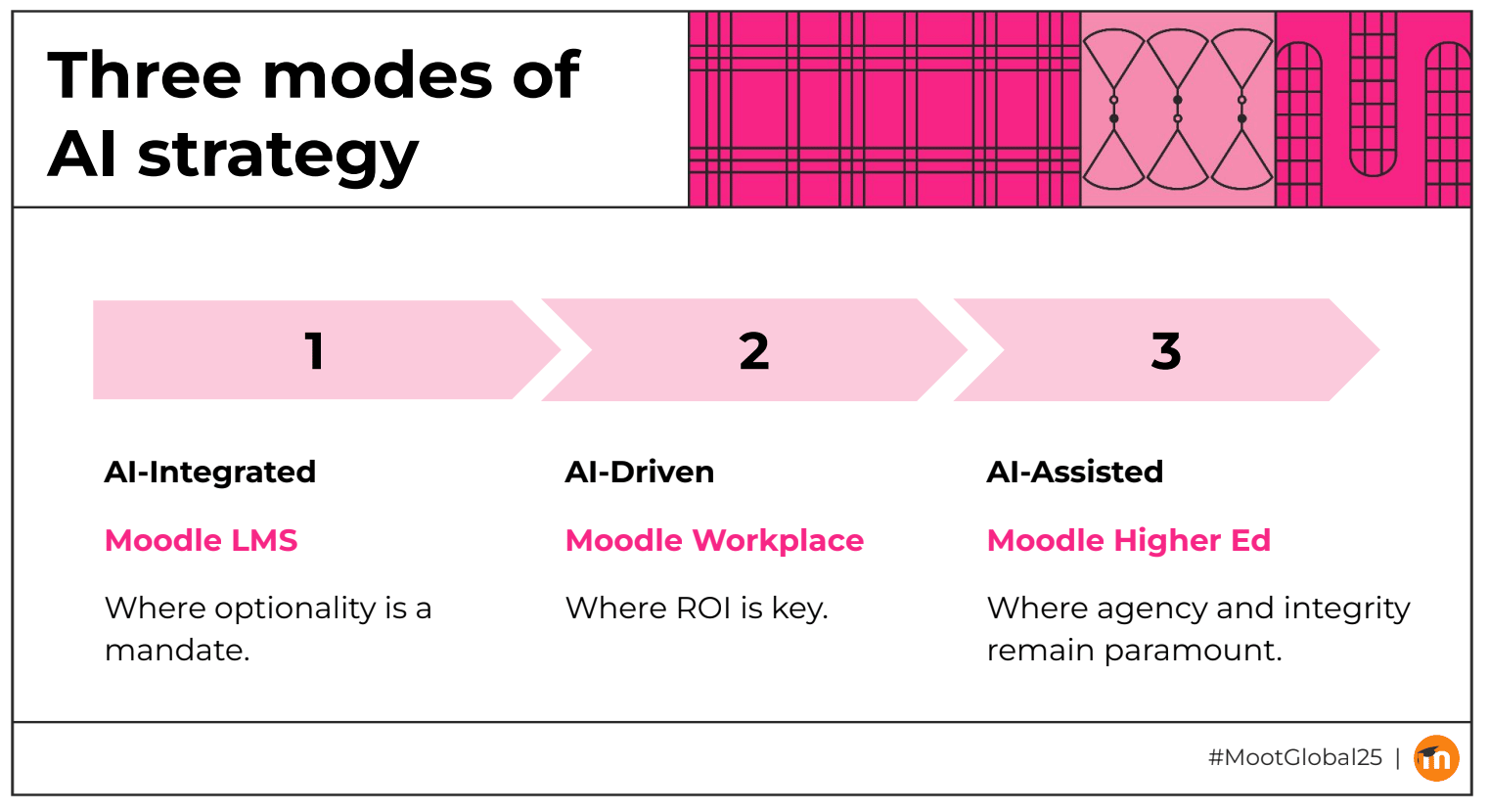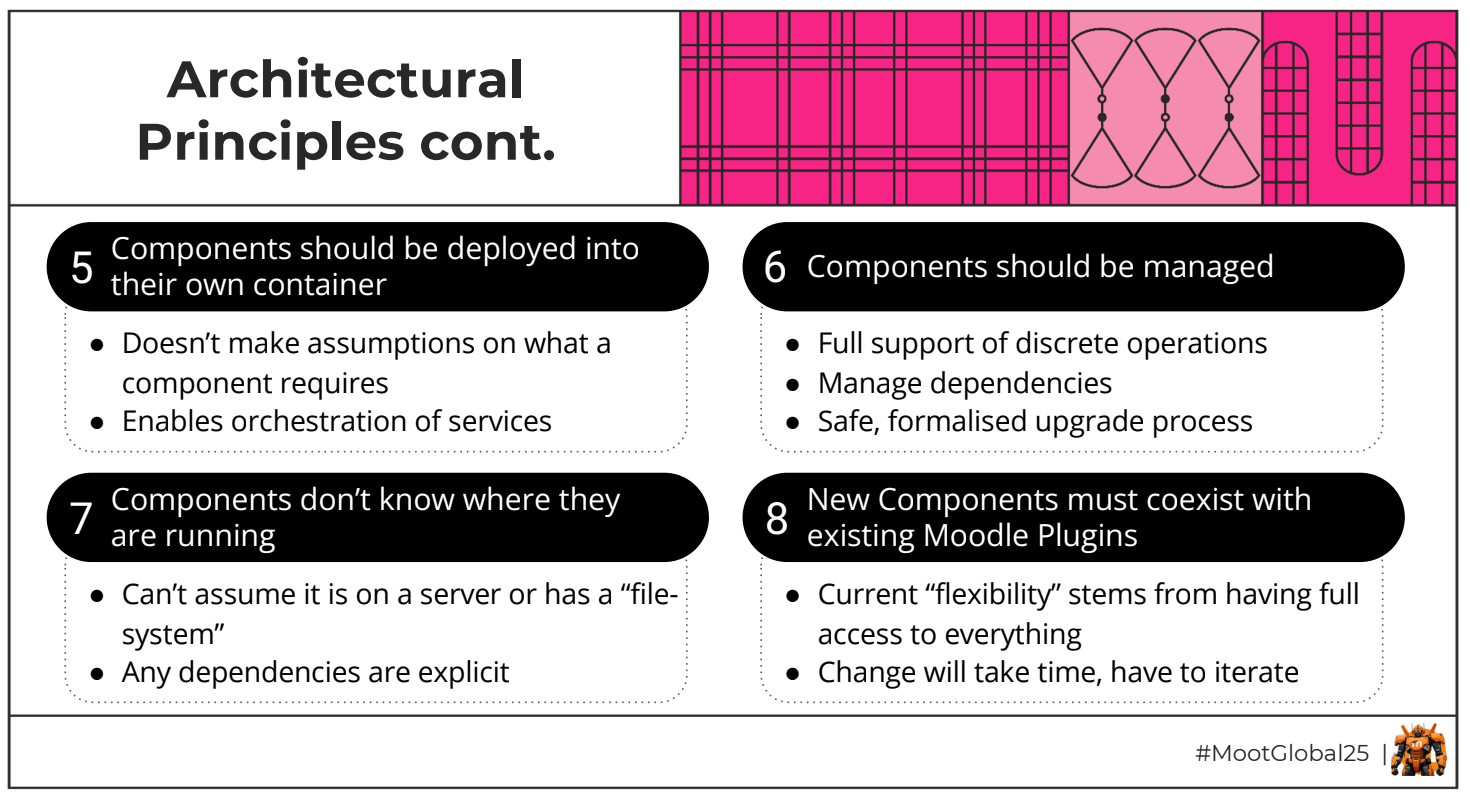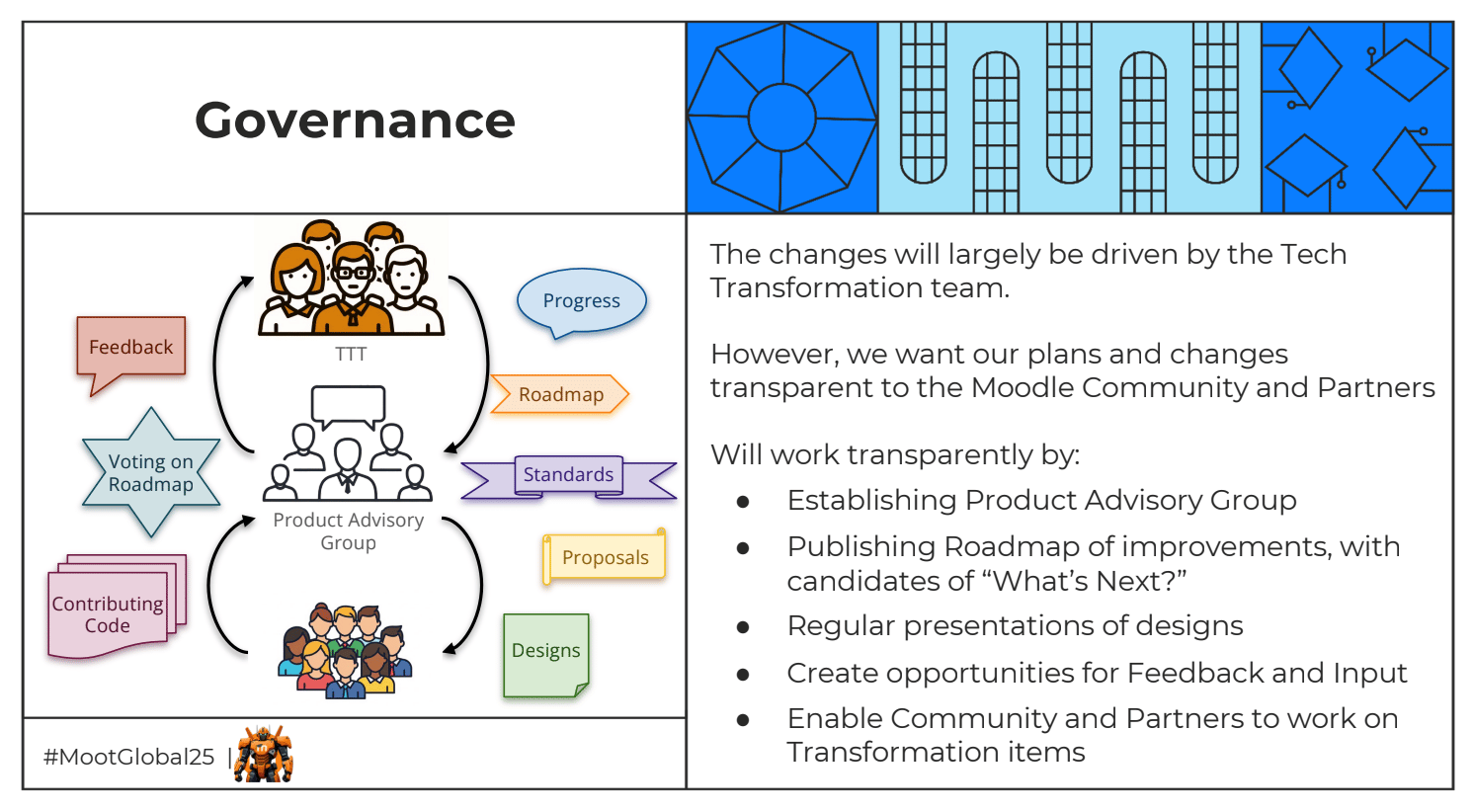MoodleMoot Global Conference Notes 2025
It's a long way from Mérida to Edinburgh

Was this forwarded to you by a friend? Sign up, and get your own copy of the news that matters sent to your inbox every week. Sign up for the On EdTech newsletter. Interested in additional analysis? Try with our 30-day free trial and Upgrade to the On EdTech+ newsletter.
Why does Moodle HQ hate chairs? For the second MoodleMoot in a row, any time I’m outside a session I find myself hunting for a seat. Meals become a balancing act—plate in one hand, notebook in the other—while I scan for a sliver of space at a standing table to set something down. I’m opening with a complaint so regular readers know it’s really me and not some Pollyanna impostor, because the rest of this post will be remarkably remarkably upbeat.
This stands in contrast to much of our past coverage, where we have noted that Moodle was becoming irrelevant in LMS evaluations and was not viewed as a modern system. In a recent Online Education Across the Atlantic podcast episode, we discussed last year’s MoodleMoot Global event [emphasis added].
Morgan: Yeah, it seemed to be mostly about comforting people that things were going to stay the same. you know, there were some obviously some changes, real changes in product, particularly in the corporate product and, a new discipline in terms of new features and things like that from Maria Shure and things like that. So there was some really positive things there. But in terms of the overall strategy, it was all “It's all good, we love education, we love non-profit, we love the whole feel-good kind of open source story,” and about comforting people rather than, this is going to be different because it's a different world we're living in, we need to do it. So it'll be interesting to see a year later. [snip]
Phil: Why can they not do a Moodle for Workplace, but do that for academia? They've shown that they have the ability to develop some pretty cool packaging of the product based on the open source core that's compelling. Yet they have so far refused to do that in academic markets when I think that's exactly what the academic markets want to see from them.
Why can they not do that as, that's my armchair product management still. Why won't they do it? There's a big opportunity for them to start gaining market share again and relevance.
On a podcast episode from November, we asked more bluntly about the revised Moodle executive team.
Are they willing to deliberately break some eggs in making a change while the old order is still there?
Despite lackluster updates in previous events, by Day Two of this year’s conference, I got the answer. Yes, Moodle is now breaking eggs and attempting a significant redesign of the platform, the governance, and the product offerings. Omelets are being made.
If Moodle HQ can execute on these plans, which is not a given, over time we’ll see a modern, user-friendly, vibrant, and sustainable suite of Moodle products. That’s good news for higher education and for anyone who wants a strong, viable open-source option in teaching and learning.
What are the new plans and what is the new vision?
During 18 minutes of deceptively low-key announcements, Chief Product Officer Marie Achour outlined a new approach to the Moodle ecosystem. I was encouraged by what she unveiled, but it was buried a little and it took me a while to grasp the full implications.
Achour started out by couching the core shift as an approach to AI within the Moodle ecosystem. This is important but it buries the lede a bit. The key point is actually point number three, the announcement of Moodle Higher Ed.

Moodle Higher Ed
This kept getting underplayed, probably because its exact shape is still undetermined and it will arrive “soon” (where, to quote Marie, “soon is a relative term”). But it’s big in that Moodle HQ is developing a premium product for higher education.
The Moodle execs were careful to say that Moodle Higher Ed won’t be an LMS, per se.
So over the next few years we're bringing something new to the Moodle product ecosystem. A tailored solution for higher education. Just as Workplace is a specialized product built on top of Moodle LMS for corporate and government needs, we're bringing that same philosophy to higher ed with an AI assistance strategy focused on point solutions that deliver real institutional value.
It is not clear what is meant by “point solutions,” but it is clear that the initial Moodle Higher Ed will sit on top of the core Moodle LMS and is aimed primarily at larger institutions. As with Moodle Workplace, it will be delivered exclusively through Moodle Certified Partners and service providers.
For years, we’ve argued that something like Moodle Workplace should be offered to higher education institutions. Moodle Workplace is a strong product with enterprise-grade features managed the way modern institutions expect. We’re finally getting something in that direction for higher education, extending the core LMS that will remain as an open source non-premium offering on its own. I’ve been hoping for a non-credit management system (badly needed in higher ed and compatible with Moodle’s “pure” LMS stance), but I suspect I’ll be disappointed on that front.
Still, a premium higher-ed product is coming. And to make it work, and work well, a lot more at Moodle needs to change, including the core platform and governance. Those changes were the substance of the other announcements and product manager updates throughout Day Two.
A new design system and back end
Moodle is moving toward a more cohesive, consistent look and feel across its products, backed by an architectural overhaul of the core platform (more on that below).

Moodle Marketplace
The current plugin directory will be replaced by a full-featured e-commerce and revenue-share marketplace. Improvements include:
Reduced clutter by hiding outdated or unsupported plugins by default
Natural-language search and improved filters
More consistent product information and layout
Direct purchasing via credit card and invoicing, with continued support for free plugins
Community ratings and reviews, sandbox trials, and a security-flagging system
This project is further along than many others: provider on-boarding begins in December, with a launch expected soon after.
Architectural redesign
These changes are all important enablers of the move toward premium offerings. But the real change came at the end of the day, from Travis Windsor, the new Director of Architecture and Engineering at Moodle HQ, outlining how the core Moodle platform is going to be rearchitected and how that process will unfold.
Windsor argued that the fact that the platform has not meaningfully evolved in years means that Moodle HQ faces several increasingly difficult challenges: difficulty hiring for needed technical skills, significant technical debt, and fragility during upgrades. He sees his mandate as crystal clear: make Moodle modern and future-ready while staying true to its core values.
To guide this transformation, Windsor introduced eight architectural principles that will steer the redesign over the next two years.


Windsor noted that in user interviews the word “monolith” came up repeatedly, reflecting broad frustration with the platform’s complexity. He also acknowledged dissatisfaction with Moodle’s UI, but emphasized that visual design is owned by product and design teams; his role is to provide the infrastructure that enables them to modernize the experience.
Governance changes
The re-architecture of Moodle will be done in a different manner than typical community structures of the past, led directly by a new Tech Transformation team.

This is another significant aspect, as it is clear that Moodle HQ is moving to a more centralized design process, still based on community input, but without the traditional open source design by committee approach.
The redesign will roll out in three stages (prepare, execute and reinforce), with a transitional period bridging the current and target architectures. The full process is expected to conclude by 2027.
Reactions were largely positive, though not without reservations. One representative from a large, well-known Moodle institution described himself as “baffled,” and much of the pushback centered on the choice to adopt React. In several sessions, users asked about Moodle HQ’s commitment to PHP, and there was concern about what “moving off” parts of the current stack might mean.
Still, the overall mood was cautiously optimistic. During Q&A, Martin Dougiamas asked for a quick “litmus test” vote on Windsor’s proposals; support outnumbered opposition by roughly 9 to 1. My conversations with users and partners outside the sessions echoed that general sense of guarded enthusiasm.
What does this mean?
Three themes stood out to me in the sessions and in conversations with Moodle leadership: a rethink of core infrastructure, a response to community pain, and a push for financial sustainability.
Investment in infrastructure. Most LMS conferences mix big-picture announcements with small tweaks driven by user requests (and it’s usually the tweaks that get the applause). While there were product features, especially in the Moodle Workplace session, this MoodleMoot leaned heavily into big-picture change, particularly the move toward premium products and need to replace aging foundations with a more modern, functional infrastructure. It’s not the sexiest work, which helps explain the at times slightly muted atmosphere.
Addressing community pain. Something I heard referenced again and again in sessions and conversations was about the pain Moodle HQ had heard about from users. They are now putting visible energy into long-standing frustrations, especially through infrastructure investments, workflow redesigns, governance processes and streamlined structures. The goal is to give users and partners a stronger voice and reduce the friction that has often characterized decision-making.
Financial sustainability, front and center. This was the dominant theme, prominent throughout the conference and in nearly every leadership conversation I had. When I asked about growth priorities, Moodle leadership didn’t emphasize new geographies or sectors (the typical LMS playbook). Instead, they highlighted two focuses: Providing managed services and Building tighter connections with users
You can see the overall changes most dramatically in the shift to Moodle Higher Ed and the redesign of the Moodle Marketplace, but also in the continued investment in Moodle Workplace. All of these are signs of an organization rethinking its business model for the long term.
I see this as a positive. Moodle is wanting to make actual products that will work for customers the income from which will allow them to thrive as an organization and continue to innovate. Moodle HQ is showing a stronger focus on product usability and a willingness to make tough, even unpopular, decisions that could make Moodle more competitive with other products and ensure stronger revenue flows. That said, there are inherent tensions and risks in the journey that Moodle HQ is starting and in how they are starting it.
Risks and open questions
While cautiously excited and impressed by the leaderships willingness to do take the tough decisions, I see several issues to watch.
Are they chickening out by not fully offering a premium LMS? I do worry that Moodle HQ are trying to thread a needle by acknowledging that they need a premium product but ultimately avoiding the hardest decision by saying that that product won’t be an LMS but will instead be something else, yet to be determined? I believe as sincere their claims that they want to listen to users in order to decide what that product is. But there seems to be a contradiction inherent in saying unequivocally that there are changes that need to be made (to product line up, to the partner program, to the technical frameworks used and to the platform architecture) but then balking at saying that it won’t be a full LMS. Are they stopping breaking eggs halfway through the carton?
Will the focus on financial sustainability alienate partners? The moves toward securing more and more predictable revenue runs the risk of alienating users, but more likely partners. Moodle HQ depends on partner revenue, and a business-model shift could strain those relationships. Some partners expressed concerns to me privately. Still, these are the kinds of hard choices required to build a stronger, more sustainable product, and I expect the tensions will be worked through over time.
Do they have time to deliver? Much of the proposed work lands “sometime in the future,” and Moodle HQ was reluctant to attach even rough dates to many changes. Meanwhile, the “pain” they referenced is very real today. Can they retain clients long enough to ship a modernized system with the features users want? By the time some of these arrive, will institutions have already moved on?
Will this impact large institutions as planned? Progress matters most for large universities. Moodle HQ emphasized that large organizations are a core target for the forthcoming Moodle Higher Ed. Moodle already serves several mega-universities (e.g., Nigeria’s National Open University, University of South Africa) with enrollments approaching half a million, but one tier down, 30,000 to under 100,000 students, Moodle has been weaker. In the US, many larger institutions were early defectors (e.g., University of Minnesota, CSU Northridge, more recently UCLA); many large Australian universities also left. Our market data consistently shows Moodle over-indexed among smaller institutions rather than larger ones. Can Moodle win back these universities with a redesigned, modern product? Are there enough mega-institutions, and enough usage among them, to sustain a premium higher-ed offering?
Can they sustain the change? At MoodleMoot Mérida last year, CEO Scott Anderberg went to great lengths to reassure the community about his commitment to education and to Moodle’s values. I worried that this could translate into hesitance to make the hard changes needed for the next phase. Those concerns were amplified by Martin Dougiamas’s continued strong presence; it felt like looking to the future while holding on to the past. The bigger question now: can they sustain this new direction? Will the community come along as substantial changes roll out? My read: there’s some confusion and concern, but overall, yes. Martin was less visibly present this time, though he remains Chairman and Head of Research. Will he back these changes as they extend into next year and beyond, especially when tensions inevitably arise? That support will be pivotal.
Next year in Istanbul
The shift from last year’s Mérida event to this year’s Edinburgh conference was striking. Starting next year, the gathering will be rebranded as the Moodle Ideas Exchange (MIX) in Istanbul. I’m looking forward to it, especially Marie Achour’s product update. This time I will be prepared, and will be strapped in!
The main On EdTech newsletter is free to share in part or in whole. All we ask is attribution.
Thanks for being a subscriber.